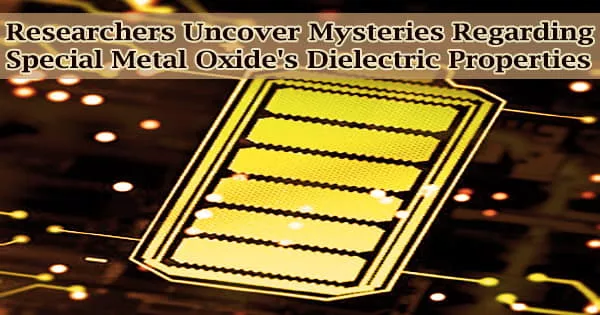Strontium titanate is a peculiar metal oxide that can be an insulator, a semiconductor, or a metal. It has long been a mystery as to why it behaves in such a peculiar way. Future uses of this material in electrical gadgets and data storage are made clear by the research.
The paper is published in the Proceedings of the National Academy of Sciences (PNAS), a peer-reviewed, multidisciplinary, scientific journal.
The negatively charged electrons and the positively charged nuclei align in the direction of the electric field when an insulator like strontium titanate is positioned between two oppositely charged metal plates.
Thermal vibrations oppose the orderly arrangement of electrons and nuclei, and the degree of order is determined by a fundamental parameter known as the dielectric constant. The dielectric constant is greater at low temperatures because thermal vibrations are less intense.
The dielectric constant is crucial in semiconductors because it effectively “screens,” or shields, the conducting electrons from other charged flaws in the material. A high dielectric constant is essential for applications in electrical devices.
Strontium titanate exhibits excellent low-temperature dielectric constant measurements of 22,000, which is fairly high and promising for applications.
But thin films would be necessary for the majority of uses in computers and other gadgets. Strontium titanate thin films have only been able to reach a moderate dielectric constant of 100–1,000 despite significant effort on the part of numerous researchers who used a variety of techniques to create thin films.
The interface between the film and the substrate or the film and the layer above can be crucial in thin films, which can only be a few atomic layers thick.
These results build on a remarkable record of success for the method of film growth, known as hybrid Molecular Beam Epitaxy, discovered by Jalan. The quality of the films from Jalan’s group is truly exceptional.
Richard James
The senior author of the study and professor and Shell Chair in the Department of Chemical Engineering and Materials Science at the University of Minnesota, Bharat Jalan, proposed that these “hidden” surfaces might be concealing the true dielectric constant of strontium titanate.
Jalan and his students found that the true dielectric constant of their strontium titanate sheets exceeded 25,000, the highest value ever measured for this material, by properly accounting for this masking effect.
The research by Jalan and his team sheds important light on the function of insulator-metal interfaces in capacitor structures, which are common in modern technology even though the insulator and metal are made of the same substance.
“Semiconductors are among the most important materials used in modern technology,” Jalan said. “While much is known about conventional semiconductors such as silicon and gallium arsenide, there are several unsolved mysteries surrounding oxide semiconductors like strontium titanate.”
Jalan said that with this research they resolved a longstanding issue concerning the low dielectric constants in strontium titanate films through defect and interface control.
“These results build on a remarkable record of success for the method of film growth, known as hybrid Molecular Beam Epitaxy, discovered by Jalan,” said Richard James, a Distinguished McKnight University Professor in the Department of Aerospace Engineering and Mechanics, and a co-author in the study. “The quality of the films from Jalan’s group is truly exceptional.”
The student leading the growth effort was Zhifei Yang, graduate student in the School of Physics and Astronomy at the University of Minnesota supervised by Jalan.
“It was quite rewarding to see that an interface only a few atomic layers thick can have a tremendous impact on the measured value,” Yang said on the discovery of high dielectric constants.
In addition to Jalan, James and Yang, the research team included University of Minnesota Department of Chemical Engineering and Materials Science researchers Dooyong Lee, and Jin Yue; Judith Gabel and Tien-Lin Lee from Diamond Light Source, United Kingdom; and Scott Chambers from Pacific Northwest National Laboratory Physical and Computational Sciences Directorate.
The research was funded by the Air Force Office of Scientific Research (AFOSR), the National Science Foundation through the Materials Science and Engineering Research Center (MRSEC) program, Vannevar Bush Faculty fellowship, and the U.S. Department of Energy, Office of Science, Division of Materials Sciences and Engineering.





